In search of Barra
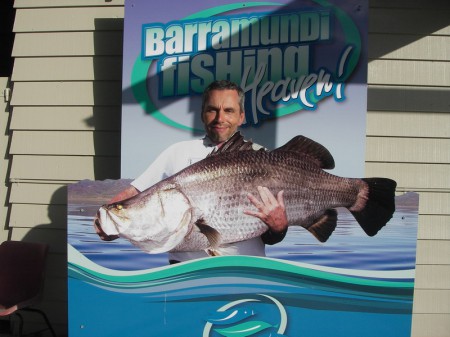 On previous trips, we fell in love with one of North Australia’s fishy icons, the elusive Barramundi (Lates calcarifer). Barramundi are closely related to the Nile perch and are not only great table fare, but grow up to 100lb and are renowned for their strength and aerial displays. They can live in fresh and in saltwater, but need the sea for their reproduction. And the males change sex when they are around 4 to 5 years old and turn into females. So whenever one catches a big, strong and clever Barra, it’s a she. Barramundi can be readily caught on lures and on fly; the fish in the dams being most active when the water temperature reaches the high twenties.
On previous trips, we fell in love with one of North Australia’s fishy icons, the elusive Barramundi (Lates calcarifer). Barramundi are closely related to the Nile perch and are not only great table fare, but grow up to 100lb and are renowned for their strength and aerial displays. They can live in fresh and in saltwater, but need the sea for their reproduction. And the males change sex when they are around 4 to 5 years old and turn into females. So whenever one catches a big, strong and clever Barra, it’s a she. Barramundi can be readily caught on lures and on fly; the fish in the dams being most active when the water temperature reaches the high twenties.
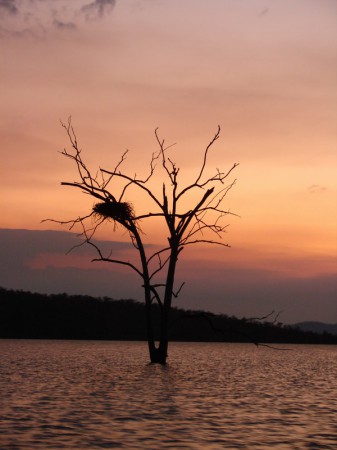 Many dams in Queensland have been stocked with Barramundi. Thanks to an abundance of food they thrive in many of these manmade lakes and grow fast and big. The entire East coast of Queensland is dotted with dams, many of them being well known for the sheer size and number of fish caught every year. One of the standouts is Lake Awoonga, home not only to one of the piscatorial icons of Australia, but also to one of its great fishing legends, Rod ‘Harro’ Harrison. We had been looking forward to meeting him in person one day, so it was no question: our next stop had to be Lake Awoonga and nearby Gladstone.
Many dams in Queensland have been stocked with Barramundi. Thanks to an abundance of food they thrive in many of these manmade lakes and grow fast and big. The entire East coast of Queensland is dotted with dams, many of them being well known for the sheer size and number of fish caught every year. One of the standouts is Lake Awoonga, home not only to one of the piscatorial icons of Australia, but also to one of its great fishing legends, Rod ‘Harro’ Harrison. We had been looking forward to meeting him in person one day, so it was no question: our next stop had to be Lake Awoonga and nearby Gladstone.
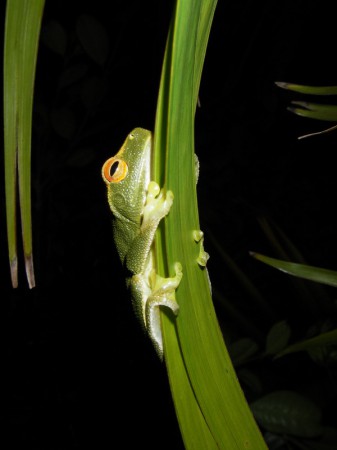 Finding a little cabin on a camp ground near Gladstone proved to be a very difficult task indeed. When the first people we ask told us, that they are fully booked for the next two years, we thought they were pulling our legs. But then they explained to us, that the area is busy with thousands of contract workers from all over Australia, working for the mining and gas industries. In the next 10 years, an estimated 30’000 new jobs will be created in Queensland.
Finding a little cabin on a camp ground near Gladstone proved to be a very difficult task indeed. When the first people we ask told us, that they are fully booked for the next two years, we thought they were pulling our legs. But then they explained to us, that the area is busy with thousands of contract workers from all over Australia, working for the mining and gas industries. In the next 10 years, an estimated 30’000 new jobs will be created in Queensland.
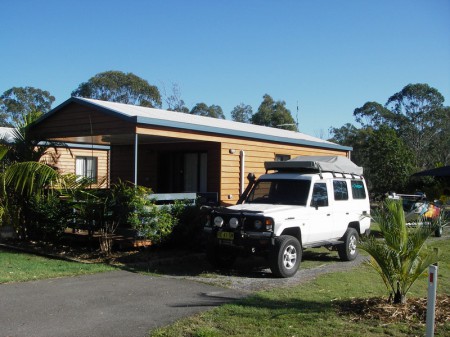 So every camp ground and caravan park was full with workers and it took us ages to finally find a cabin. We got lucky though and found a great place just minutes from the lake. Lake Awoonga Gateway Lodge was our home from home for several weeks and we were even treated to 2 days of fishing with our very friendly and knowledgeable host Marc. The weather was still on the cooler side for Barra fishing and the water temperature just scratching 20°C. The fish did not what we wanted them to do and our lures couldn’t tempt a single Barra.
So every camp ground and caravan park was full with workers and it took us ages to finally find a cabin. We got lucky though and found a great place just minutes from the lake. Lake Awoonga Gateway Lodge was our home from home for several weeks and we were even treated to 2 days of fishing with our very friendly and knowledgeable host Marc. The weather was still on the cooler side for Barra fishing and the water temperature just scratching 20°C. The fish did not what we wanted them to do and our lures couldn’t tempt a single Barra.
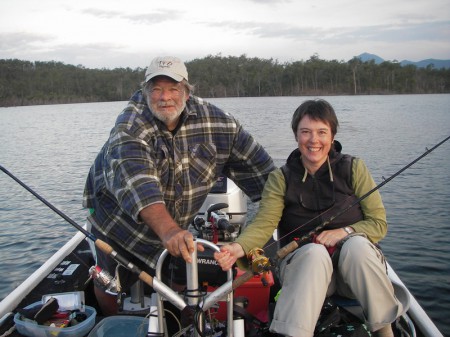 Meeting Harro was a pleasure and spending an afternoon on the lake with him was a great experience and we learned a lot. But even his knowledge and skills couldn’t change the conditions and we did not get a Barramundi. To have a bit of action, we started fishing for catfish with shrimps and got one fish after the other until we ran out of bait. The slow fishing left plenty of room for talking and a humble Rod Harrison told us many funny and fantastic stories out of his very colorful life. We hope to see him again and spend some more time together. Harro is also a master fly caster and teacher and we would love to throw a line with him.
Meeting Harro was a pleasure and spending an afternoon on the lake with him was a great experience and we learned a lot. But even his knowledge and skills couldn’t change the conditions and we did not get a Barramundi. To have a bit of action, we started fishing for catfish with shrimps and got one fish after the other until we ran out of bait. The slow fishing left plenty of room for talking and a humble Rod Harrison told us many funny and fantastic stories out of his very colorful life. We hope to see him again and spend some more time together. Harro is also a master fly caster and teacher and we would love to throw a line with him.
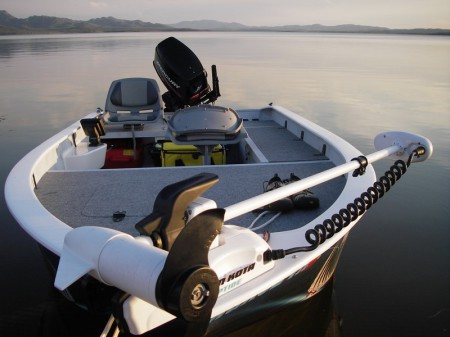 There is more to Gladstone than Lake Awoonga and we spent many days exploring the area. Construction work is going on everywhere and not everyone is happy about it. The installation of mining and gas exploiting sites and the necessary infrastructure like roads, railway tracks and port facilities have a great impact on the environment. Many people we came across and some of the political parties are concerned. Labour and the Greens want to investigate the issue properly, while the National party – without knowing what’s going on either- assures everyone, that it is save any way and that none of these activities have any negative impact what so ever. Once more their policy is to look the other way and not to ask any questions regarding environmental issues, whenever money is to be made and votes can be won.
There is more to Gladstone than Lake Awoonga and we spent many days exploring the area. Construction work is going on everywhere and not everyone is happy about it. The installation of mining and gas exploiting sites and the necessary infrastructure like roads, railway tracks and port facilities have a great impact on the environment. Many people we came across and some of the political parties are concerned. Labour and the Greens want to investigate the issue properly, while the National party – without knowing what’s going on either- assures everyone, that it is save any way and that none of these activities have any negative impact what so ever. Once more their policy is to look the other way and not to ask any questions regarding environmental issues, whenever money is to be made and votes can be won.
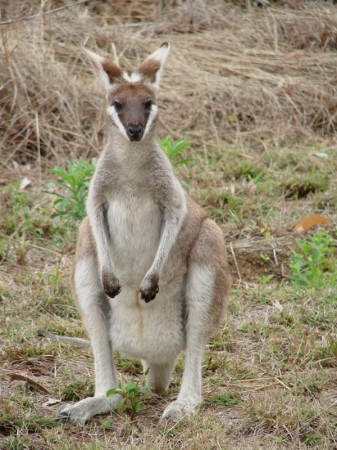 In Gladstone harbour, dredging on a big scale is already going on. Recent sightings of unusually high numbers of dead dugongs and turtles have raised questions about the cause of these deaths and the role the dredging may play. We can only hope, that despite the fact that jobs and a thriving economy are vital for Queensland and Australia, sustainability and the need for a healthy environment are not just meaningless words.
In Gladstone harbour, dredging on a big scale is already going on. Recent sightings of unusually high numbers of dead dugongs and turtles have raised questions about the cause of these deaths and the role the dredging may play. We can only hope, that despite the fact that jobs and a thriving economy are vital for Queensland and Australia, sustainability and the need for a healthy environment are not just meaningless words.
Gladstone, nearby Curtis Island and several rivers are part of a very diverse mosaic of waterways, mudflats and mangrove rich estuaries, providing habitats for an amazing number of mammals, birds, fish and other marine life. We spent hours walking the beaches and fishing from the shore and from a pontoon on Boyne Island. And we had the pleasure to see dozens of pretty-faced wallabies, and, in the water, the odd dugong and many turtles.
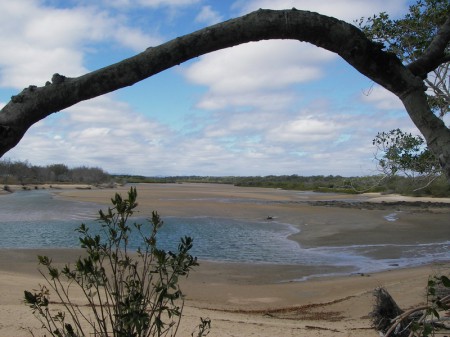
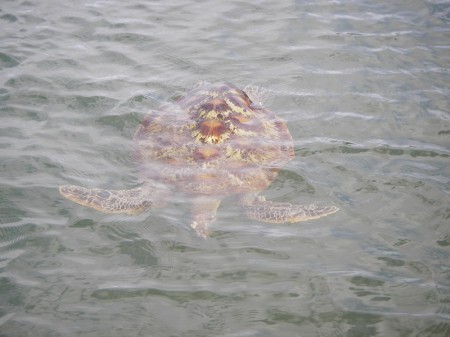
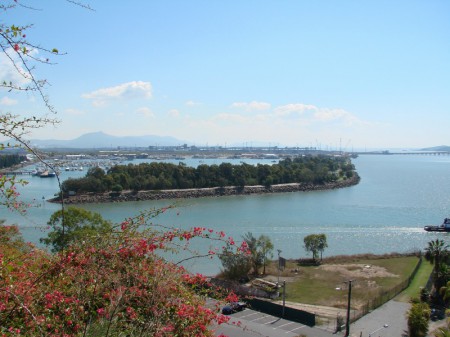 One of the world largest alumina refineries, Queensland Alumina Ltd (QAL), is based in Gladstone and is a major employer, providing work for more than 1’000 people. The plant itself covers an area of 80 hectares and started working in 1967, currently producing more than 4 million tonnes of alumina per year. Alumina, a fine aluminium oxide powder, is produced by refining bauxite; the process being very energy and water intensive and requiring the use of 800’000 tonnes of caustic soda annually as well. The bauxite for QAL is mined in Weipa on Cape York and shipped 2’000km around the Cape to Gladstone. Alumina is delivered to smelters in Australia and overseas and smelted into aluminium. 4 tonnes of bauxite produce 2 tonnes of alumina which result in 1 tonne of aluminium.
One of the world largest alumina refineries, Queensland Alumina Ltd (QAL), is based in Gladstone and is a major employer, providing work for more than 1’000 people. The plant itself covers an area of 80 hectares and started working in 1967, currently producing more than 4 million tonnes of alumina per year. Alumina, a fine aluminium oxide powder, is produced by refining bauxite; the process being very energy and water intensive and requiring the use of 800’000 tonnes of caustic soda annually as well. The bauxite for QAL is mined in Weipa on Cape York and shipped 2’000km around the Cape to Gladstone. Alumina is delivered to smelters in Australia and overseas and smelted into aluminium. 4 tonnes of bauxite produce 2 tonnes of alumina which result in 1 tonne of aluminium.
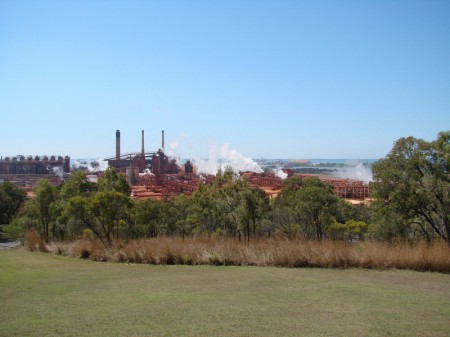
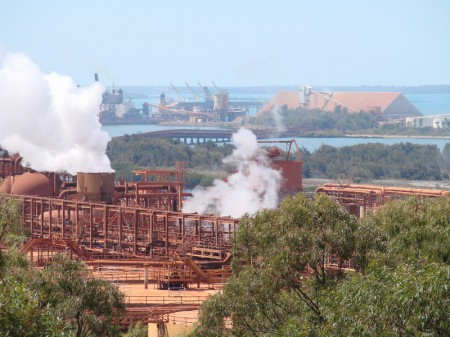
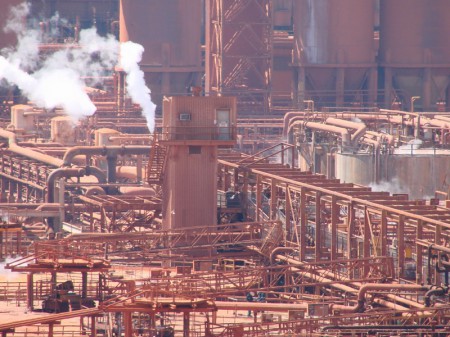 QAL runs free visitor tours and the tour by bus through a maze of pipes, buildings and conveyors was very impressive indeed.
QAL runs free visitor tours and the tour by bus through a maze of pipes, buildings and conveyors was very impressive indeed.